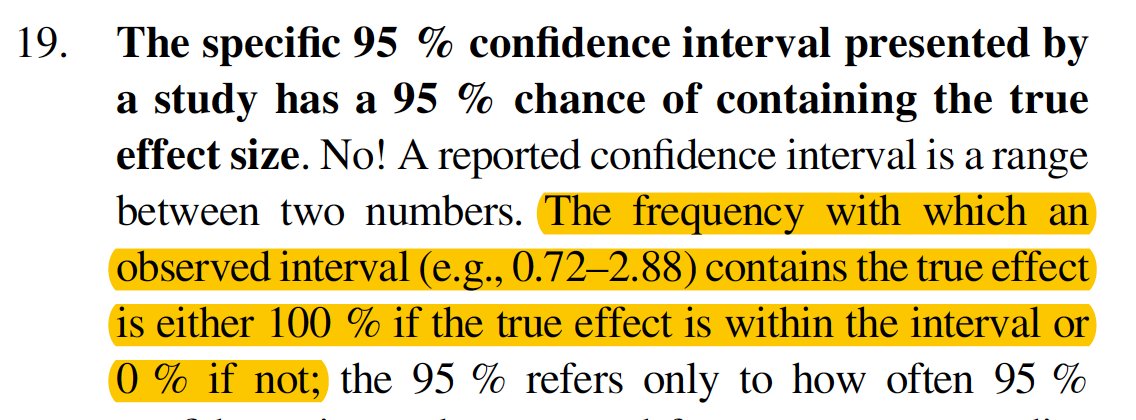About confidence interval interpretation. Motivated by the results of this poll
[Thread]
(1/16) https://twitter.com/MaartenvSmeden/status/1058401290936635392">https://twitter.com/MaartenvS...
[Thread]
(1/16) https://twitter.com/MaartenvSmeden/status/1058401290936635392">https://twitter.com/MaartenvS...
Most of us have probably been taught about 95% confidence intervals and their interpretation in rather vague terms. Such as "the limits reflecting the uncertainty in the parameter estimate" or "95% confident about the true value of the parameter"
(2/16)
(2/16)
You may also remember the warning that usually comes with it: 95% *confidence* doesn& #39;t mean 95% *probability* that the true value is actually in the confidence interval
(3/16)
(3/16)
Nothing wrong so far. All true. In fact, the only thing we know for sure* is that 95% of confidence intervals contain the true value of the parameter 95% of the time.
*actually this only true if all the assumptions used to compute the intervals were correct
(4/16)
*actually this only true if all the assumptions used to compute the intervals were correct
(4/16)
The chance that any particular confidence interval contains the true value is an all or nothing game, as this great paper explains: https://link.springer.com/article/10.1007/s10654-016-0149-3
(5/16)">https://link.springer.com/article/1...
(5/16)">https://link.springer.com/article/1...
Does that sounds like playing with words? Okay, but stay with me for a few more seconds
(6/16)
(6/16)
If you have ever come across Bayesian inference, you probably know that their alternative to the confidence interval is the so-called credible interval that *does* come with the 95% *probability* that the true value is in the interval interpretation
(7/16)
(7/16)
Problem solved, right? Just go Bayesian. Well, maybe, but it might not be that easy. To get a credible interval around a single parameter estimate (say, a regression coefficient) we have to predefine a so-called prior distribution for that coefficient
(8/16)
(8/16)
Prior distributions are probability distributions that define - before looking at the data - how likely you belief/think/expect different values for the parameters are
(9/16)
(9/16)
It doesn& #39;t have to be *that* complicated. We can just say that for a very large range of values all values are equally likely. This is sometimes called a "flat prior" or "uninformative prior"
(10/16)
(10/16)
For simple situations, the Bayesian analysis with such a flat prior will give a credible interval with an upper and lower limit that is numerically equivalent to the standard confidence interval ("frequentist") analysis
(11/16)
(11/16)
Hey! That means I can interpret my confidence interval as a credible interval with a flat prior? Yes and no
(12/16)
(12/16)
The problem lies in assuming a flat prior. Unfortunately, the flat prior is often an unrealistic prior in the life sciences. As my colleague Erik van Zwet has recently worked out: https://github.com/ewvanzwet/default-prior
(13/16)">https://github.com/ewvanzwet...
(13/16)">https://github.com/ewvanzwet...
In fact, he shows that to get a confidence interval that approximately has a probability interpretation you have to divide the parameter estimate by 2 and the estimated standard error by the square root of 2 (see his GitHub  https://abs.twimg.com/emoji/v2/... draggable="false" alt="👆" title="Up pointing backhand index" aria-label="Emoji: Up pointing backhand index"> for more info)
https://abs.twimg.com/emoji/v2/... draggable="false" alt="👆" title="Up pointing backhand index" aria-label="Emoji: Up pointing backhand index"> for more info)
(14/16)
(14/16)
Yes, this will get you a completely different interval than simply calculating the confidence interval
(15/16)
(15/16)
The bottom line is this: to be able to justify saying that there is a 95% *probability* that the true value is within a particular interval, you may have to do some extra calculations. The standard confidence interval doesn& #39;t come with a 95% probability interpretation
(16/16)
(16/16)

 Read on Twitter
Read on Twitter


